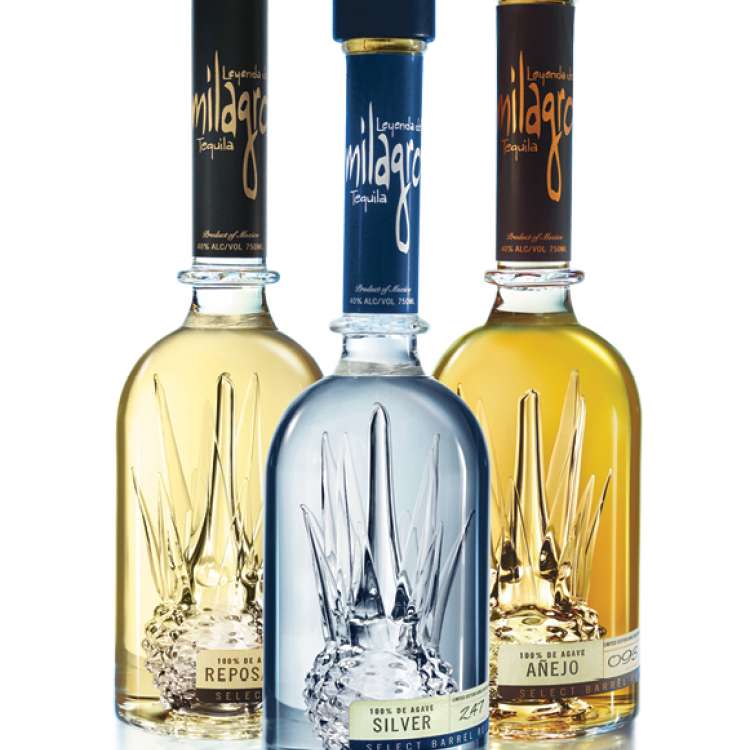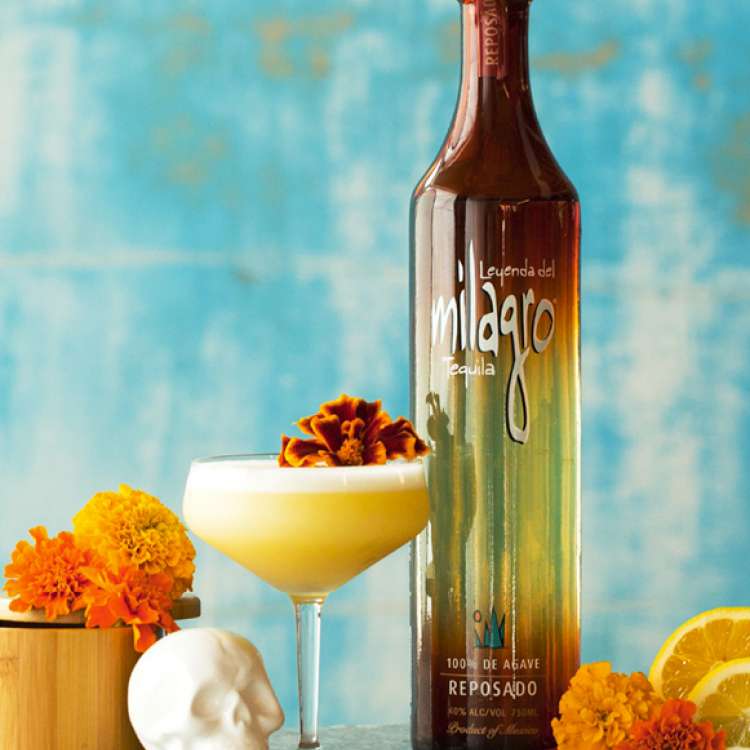The Blue Agave’s Kosher Kick

Did you know most tequilas are kosher? We certainly didn’t. Then along came Milagro with their stunning bottle designs, their smooth tastes and their concentrated efforts on actually branding their tequila as kosher.
It took 18 months from concept to first bottle production for Milagro, which has now become a leading brand in the tequila industry. We caught up with founders Danny Schneeweiss, 44, and Moises (Moy) Guindi, 43, at their homes in Mexico City to learn more about their history as friends and business partners, what makes Milagro so special, and why they are connecting their alcoholic spirits with their Jewish spirits.
How did you guys meet?
Moy: We met by coincidence in a classroom in college in 1993. We connected. One of our courses was entrepreneurship. Danny and I were on the same team. They graded you based on two different matters. They’d give you $100 to invest in different projects (created by our classmates). Then you’d present what you invested in to the class. Danny and I made a project about recycling and we were able to pull 90% of the money invested from the class. We said, “We make a pretty good team and we should do something after college.”
So you naturally chose tequila.
Danny: We had no background in tequila. In my case, my family’s business, glass production, was full of other brothers and cousins and they said, “You know what, there’s no more room for other family members.” We decided to look for something else. One of the things we saw in tequila was that everything looked exactly the same. Every bottle was communicating the exact same message about old Mexico and the horses and the sombreros. That wasn’t the Mexico we grew up in. We were living in Mexico City, which is full of great design and great architecture. Mexico was becoming more than horses and sombreros. Tequila was now becoming an ambassador of Mexico to the world. It had just gotten the denomination of origin. We wanted to show something more of what our country means to us and where we grew up. That’s how we decided to start Milagro, not only from the packaging perspective but from the tequila itself. We started going into the highlands and began falling in love with the agave and eventually, when we tasted the cooked agave, we said, “Wow. This is what tequila should taste like.”
Were there any other alcohols that influenced you?
D: There was a big revolution in the vodka industry. They were evolving this way. You started seeing the change from traditional Russian looking bottles to something more contemporary. It was more sophisticated. Grey Goose and Belvedere, for example, they were putting vodka at a different level. We saw that spirits could be presented in a different way. It was breaking the mold. Tequila is a very old industry in Mexico. Just coming out with this tall, clean blue bottle was a huge change. Now most of the tequilas out there have adopted blue as their color. It wasn’t like that when we started. We wanted to do blue because of the color of the agave, we wanted a shaded blue bottle as a tribute to the agave.
Tell me more about agave. What makes your agave processing so special in regards to the tequila?
M: Most of the other spirits back then were trying to mimic other spirits through the aging or some other addition of elements to the tequila like coloring to make it look and taste like a scotch. We fell in love with the agave. Our master distiller, Pedro Juarez, had 30 years in the industry and he was always asked how can we make this cheaper or faster or how can we use less agave to produce it. We asked, “How can we make this taste as close to the agave that were coming out of the ovens?” We wanted to leave the agave as untouched as possible. The entire concept was to create an agave forward tequila and that’s where the genius of Pedro came into play.
D: Agave separates tequila from any other spirit. When they drink our tequila they know they are drinking part of Mexico.
How do you impart that flavor into the tequila?
M: The best agave has ability to release the most flavor. That meant the best and most mature agave from the highlands. The way to cook that agave is a crucial step for achieving what you want out of tequila. We went back to the traditional method of cooking the agave in a Greek oven for 36 hours. This agave takes 8 - 10 years to mature and then once you harvest them, you have to start again from scratch.
Why did you choose the name Milagro?
M: It comes from the combined method of distillation where we did the initial distillation in pots. Then we distilled through a column. What Pedro was achieving is first capturing all the flavors from the agave in the pot still and then utilizing the column more as a polishing process to get rid of the flavors that didn’t belong in the agave group and keeping the ones that belonged to the agave. This was the first time it was ever used in the tequila industry.
The result was a true miracle which is where the brand name comes from. Milagro means miracle.
One last question about agave: You mentioned that you source your agave from the highlands. Is the region the agave comes from important to the tequila?
M: Big companies were establishing the lowlands 200 years ago. Slowly, they started understanding that the quality of the soil in the highland, because of the weather conditions and the integration of color and soil, had much richer soil to ensure that the agave is better. All of the tequila distilleries that were based in the lowlands started sourcing their agave from the highlands. The new distillers established themselves in the highlands because of the raw material. That means a much more herbaceous and expressive agave that means a more expressive tequila.
You guys were doing something different than everybody else. Did that make Milagro a hit right away?
D: Through a friend of a friend, we got an appointment with one of the biggest distributors in the US, in Florida, with Southern Wine and Spirits. Moy and I go to see Mel Dick (President Wine Division / Senior VP at Southern Wine & Spirits of America). He said, “You have 15 minutes and just to let you know this is the 9th tequila brand we’ve been presented this week.” We started shaking and we pulled out a bottle of Milagro. That got his attention because he saw the beautiful blue bottle. He tasted it, loved the product, and said, “This is great. I’ll take one container.” That’s a lot of cases. Moy and I left saying “This is the easiest job in the word. We just have to do this and we’ll be millionaires. It’s easy.”
We went back to Mexico, made all the tequila, bottled it and sent it. Some months later we went to the warehouse and all the containers were sitting there. That’s when we understood that there’s a lot that you need to do to sell your brand anywhere, in many markets, let alone the US. That’s when we knew there was a lot of work to be done. We were not a company with the resources and budget for marketing, so our marketing was a lot of putting our bottle out there. Our best billboard was the bottle itself on the shelves. There was a lot of hand-selling of the product.
M: The great thing about Milagro is that we were in the right place at the right time. Every single brand on the shelves spoke about this old Mexico and the shelf was quite different than it is today. When you look at the tequila side, it was super different. It seemed like tequila was a second-class spirit. Milagro was really evolving the category and that made it so much easier.
Let’s talk about the bottles.
M: Danny and I were both raised in Mexico City. 99% of the tequilas that existed back then were owned by generations of old Jalisco producers. We stood for something more urban, more cosmopolitan. I think Milagro reflects that energy and design and passion that you can find in Mexico City.
D: Mexico was evolving as a country and part of that Mexico was the evolution in design, architecture, etc… The bottles needed to reflect this evolution and stand out proud on the shelves as one of the best spirits in the world. The iconic Milagro blue bottle represents the blue agave which is the core of our vision and wants to generate its flavor through a spirit that doesn’t touch the wonderful flavors of it.
Did your family’s background in the glass production business play a part in the bottle designs?
D: No. We were the ones that developed the design and overall look for Milagro. The glass plant was very helpful in making sure everything went smooth and we had their support on our project.
Why is it so important to you that Milagro is branded as kosher?
M: Both Danny and I belong to the Jewish community in Mexico City. Danny is Ashkenazi and I am Sephardic Jew. We brought the rabbis and everybody to the distillery and ensured that we worked hand by hand with both communities, the Ashkenazi and the Sephardic, so it complies with both communities in Mexico. If you don’t add anything artificial, you will end up with something kosher.
When we started the business, we were 23 and single. As tradition states, if you are going to get married in the synagogue and you are going to have the celebration there, you need to keep all the food and drinks kosher. We said, “If we are eventually going to get married, we need to celebrate with our own tequila.” Being kosher was important for our family celebrations.



